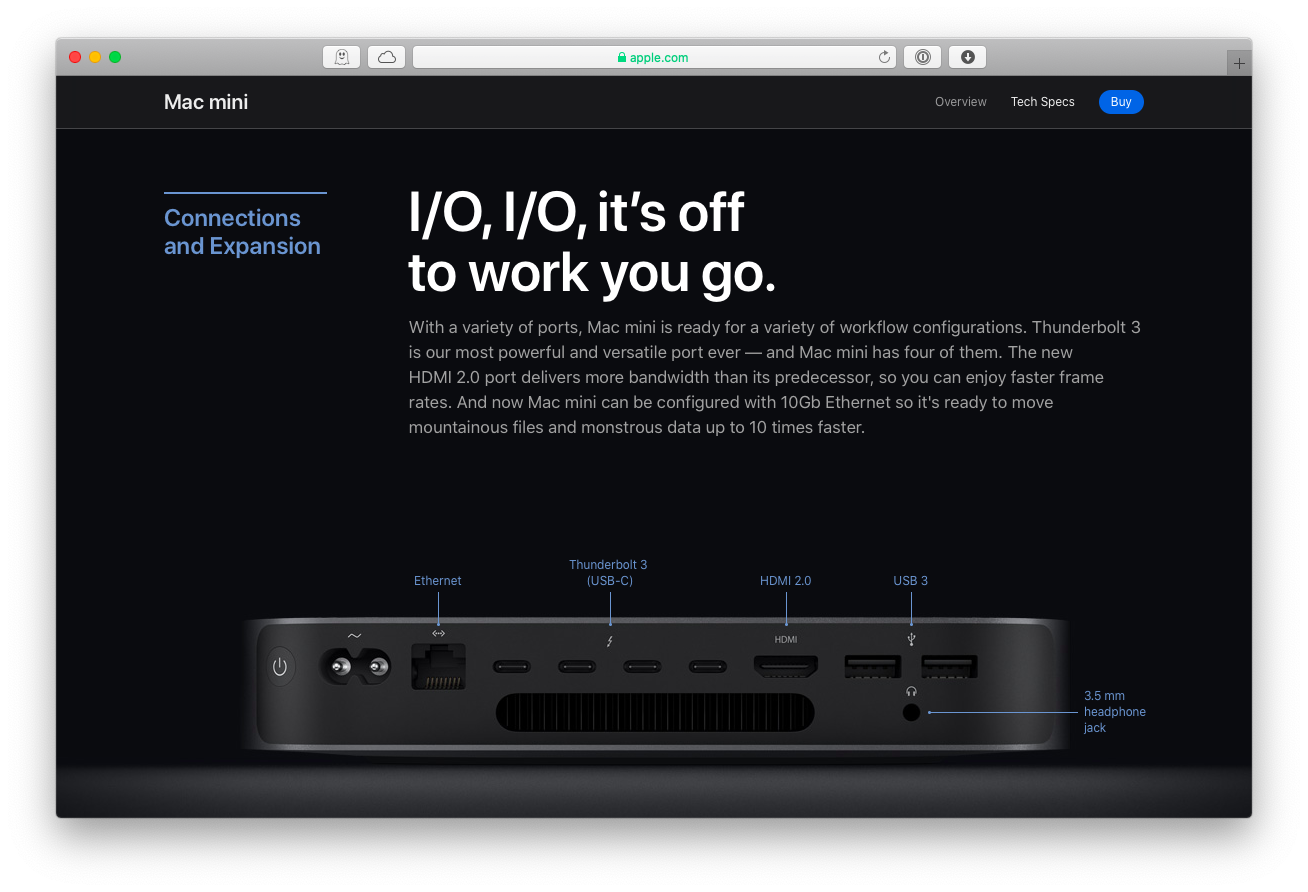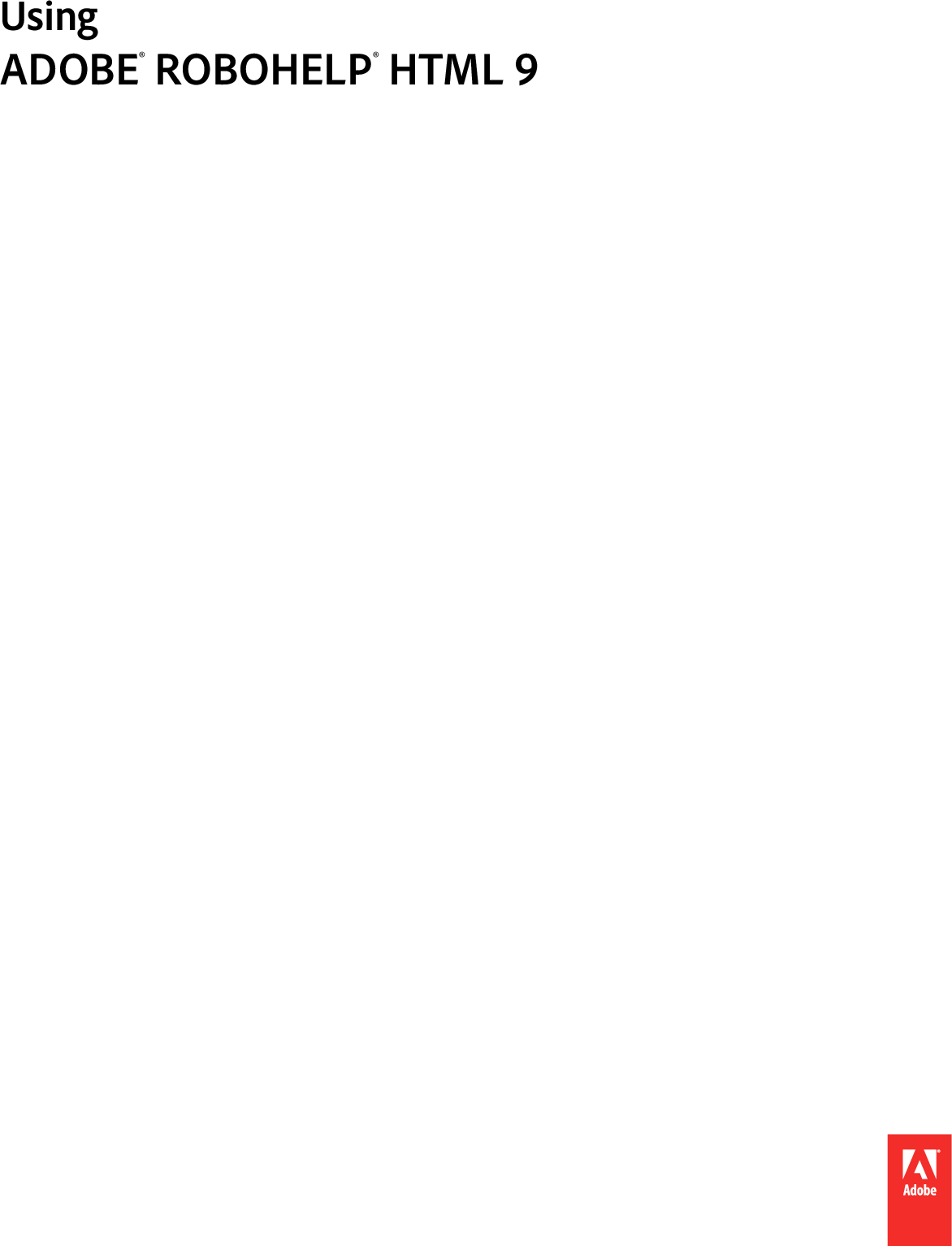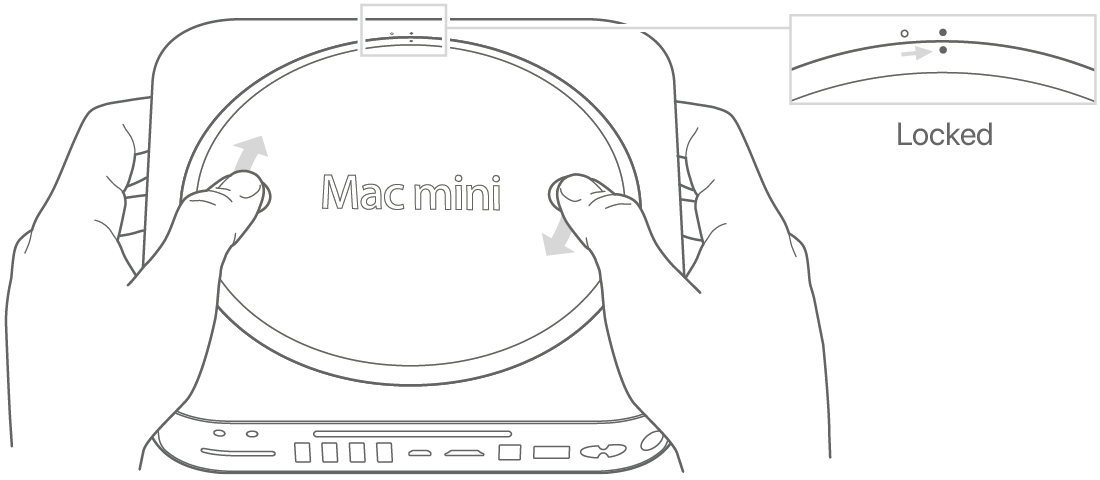New Mac Mini Ram Upgrade
Before you begin
To minimize the possibility of damage to the computer components due to static discharge, it's important to wear an antistatic wrist strap while you work with your computer's memory.
2010 Mac mini: RAM, Hard drive, Logic board, fan, etc In most makes of Mac Mini you can't upgrade the processor - for models released since 2009, processors have been soldered onto the motherboard.
Choose your model
Never operate your Mac mini without the cover in place. Replace the bottom cover using the alignment dots to place it in the unlocked position. Rotate the cover clockwise to lock it in place. Reconnect the power cord and any other cables you disconnected. After you install the memory, confirm that your Mac mini sees the new memory. How to upgrade the RAM in your shiny new 2018 Mac mini. Mac mini Late 2014 Hard Drive Replacement Replace the hard drive in a Late 2014 Mac mini. The Mac mini is a desktop computer made by Apple Inc. It was introduced in January of 2005. It is uncommonly small for a desktop computer, and its. How to upgrade RAM on a Mac Mini. Due to the form factor of the Mac Mini, it is one of the more challenging devices to upgrade. We recommend getting help from professionals or someone that has experience upgrading Mac Mini RAM. Back in the day, a Pro Mac meant a computer you could upgrade, configure, and connect as you pleased. This new mini aligns so well with that ideal that we're surprised it didn't earn itself a 'Pro' title—especially compared to the increasingly closed-off MacBook Pro line.
Mac mini models have different memory (RAM) installation requirements. Choose your Mac mini model for more information. If you need help determining which Mac mini you have, find out how to identify Mac mini models.
2020
Mac mini (M1, 2020)
2018
Mac mini (2018)
2014
Mac mini (Late 2014)
2012
Mac mini (Late 2012)
2011
Mac mini (Mid 2011)
2010
Mac mini (Mid 2010)
2009
Mac mini (Late 2009)
Mac mini (Early 2009)
2007
Mac mini (Mid 2007)
2006
Mac mini (Late 2006)
Mac mini (Early 2006)
2005
Mac mini (Original)
2020
Mac mini (M1, 2020) has memory that is integrated into the AppleM1chip and can't be upgraded. You can configure the memory in your Mac mini when you purchase it.
2018
Mac mini (2018) does not have user-installable RAM. You can configure the memory in your Mac mini (2018) when you purchase it. To upgrade the memory in your Mac mini (2018), go to an Apple Store or Apple Authorized Service Provider.
RAM availability varies by country and region.
2014
Mac mini (Late 2014) has memory that is integrated into the main logic board and can't be upgraded.
2012, 2011, 2010
To remove and install memory in your Mac mini (Late 2012), Mac mini (Mid 2011), or Mac mini (Mid 2010), use the following steps.
Remove the bottom cover
- Turn off your Mac mini. From the Apple menu (), choose Shut Down.
- Disconnect the power cord and all other cables from your Mac mini.
- Lay your Mac mini upside down on a soft cloth or towel, and then rotate the bottom cover counterclockwise to the unlocked position.
- Press on the cover to pop up the opposite side, and then remove the cover.
Remove the original memory modules
- Gently spread the clips at the ends of the top memory module just enough to let the free edge pop up.
- Pull the module out of the slot.
- Repeat to remove the second, bottom module.
Install the new memory
- Carefully press the notched edge of the new memory module into the bottom slot while keeping the opposite edge slightly raised.
- Press down on the raised edge until the clips snap into place.
- Repeat to install the top memory module.
Replace the bottom cover
Don't connect the power cord or turn on your Mac mini until you replace the bottom cover. Never operate your Mac mini without the cover in place.
- Replace the bottom cover using the alignment dots to place it in the unlocked position.
- Rotate the cover clockwise to lock it in place.
- Reconnect the power cord and any other cables you disconnected.
After you install the memory, confirm that your Mac mini sees the new memory.
2009 and earlier
To remove or install memory in the following Mac mini models, go to an Apple Authorized Service Provider.
Confirm that your Mac sees the new memory
To check that the computer recognizes the new memory:
- Start up your computer.
- When you see your desktop, choose Apple menu , then choose About This Mac.
- Confirm that the memory listed matches the memory you installed.
If the reported memory size isn't correct or if your Mac mini repeatedly plays three tones, it may be having trouble recognizing a memory module. If this happens, shut down your Mac mini, verify the module specifications against the requirements for your Mac mini model, and then repeat the memory installation instructions to make sure that the modules are installed correctly. If you still have issues, remove the memory and consult the support information that came with the memory, or contact the vendor who provided the memory.
Is your Mac slowing down? Do you spend more and more time waiting for applications to do what you want? If so, there is a very good chance that you have high memory usage and need a Mac RAM upgrade.
Apple Mac Mini 2014 Ram Upgrade
What is RAM?

RAM stands for Random Access Memory. This memory is temporary and used by the CPU to hold information that processes are actively using on your system. Your Mac slows down when it experiences high memory usage, in other words, when the running applications demand more RAM than your Mac is able to provide. The more RAM available, the better your Mac is able to execute on the tasks that are being thrown at it.
The obvious solution would be to increase Mac RAM, but before we show you how to do that, let’s make sure that your lack of RAM is actually the cause of your Mac slowdown.
Note: Not all devices are able to upgrade RAM, like the MacBook Air and the 2014 edition of the Mac Mini.
How to manually check Mac RAM
Checking your RAM is dependent on the version of macOS that you have installed. You should check your Mac RAM after you have been using your Mac for a bit of time. When you are in the middle of normal daily tasks, follow these steps.

- Open Spotlight Search.
- Type in ”Activity Monitor”.
- Click on the “Memory” tab on the top of the window.
Memory Pressure is the graph you need to study.
If there is mostly green, your system RAM is currently fine. If there is a lot of yellow, the jury is still out. If there is a lot of red, your memory is under strain and your Mac has a high memory usage.
Older OS X versions like Leopard and Lion
For older versions of Mac OS X the steps are the same but the System Memory tab looks a bit different. You’ll want to look for Free and Page Outs.
Free – This is how much free RAM your Mac currently has. If you’ve got a bunch of applications open and there is still a good number of free RAM, then your Mac may have enough memory.
Page Outs – This number tells you how often your Mac has run out of RAM and needed to use the slower hard disk instead. A high number here is very bad and a sure sign that your Mac doesn’t have enough RAM.
Use a Mac memory analysis tool

Another alternative, which will work easily on all versions of Mac OS X, is to use a 3rd party tool to check your RAM usage. I highly recommend CleanMyMac X, which will not only clean and speed up your Mac, it also has a RAM monitoring tool called Menu App.
When you install CleanMyMac X, click on the Maintenance tab in the sidebar.
Here you can free up RAM with just one button. When to use this tool? When your Mac or a particular app hangs up, this feature will temporarily flush memory, helping your Mac to unfreeze.
CleanMyMac X has a free version you can download. So try it out and get to the bottom of your high memory usage problem.

Note: With all above solutions we recommend checking the results on a regular basis until you are certain that your Mac needs a RAM upgrade.
How to upgrade your Mac RAM
If you have reached the conclusion that you need more memory, we are going to show you exactly how to increase your Mac RAM. Don’t worry if you’ve never done it before, as this guide will help you every step of the way.
The first steps are to gain knowledge about your system. This will help ensure that the RAM that you get will be compatible with your system.
Step 1 – What kind of Mac do you have?
Whether you have an iMac, a MacBook Pro, or any other kind of Mac, there is a lot more information to be found out in order to identify your exact system. To get these details, follow these easy steps:
- Click on the Apple icon.
- Select “About this Mac.”
- View your system information.
Step 2 – Do I have space for more RAM in my Mac?
This may not be what you want to hear but it’s possible that you can’t add more RAM to your Mac, even if you wanted to. Let’s look under the hood and see what your RAM situation is like.
- Following on from Step 1, click on “More Info” on the “About this Mac” window.
- The complicated looking System Profiler will launch. Click on “Memory” in the left column.
On the right you will see exact details of your RAM modules or sticks. The “banks” are the slots that the RAM is inserted into. If you have an empty bank or two, you’re in luck, upgrading your Mac RAM just got that much easier.
Step 3 – Check how much RAM your Mac can take
Now let’s really make sure you can upgrade your RAM. Head over to Technical Specifications on Apple Support, find your exact Mac model. Once you find your Mac, click it to reveal a ton of information. What you’re looking for is the information, which will tell you how much RAM your system can work with. Compare it to your Mac’s current RAM (from Step 2) and now you know if you can upgrade your RAM or if you are stuck with what you have.
If you can’t upgrade your Mac RAM, download CleanMyMac X and use all of the cleaning tools to boost your Mac performance. You should also take a look at the performance improving solutions found in How To Fix Mac Running Slow.
Step 4 – Purchasing RAM for your Mac
In Step 3 you navigated to your Mac model and discovered what memory your system could potentially add. Now it's only a matter of choosing your new RAM and we recommend to start with this source. If you're located outside of the US, Google will probably tell you which stores sell RAM nearby.
Step 5 – Installing RAM into your Mac
Adding your new RAM into your Mac is not as hard as it sounds. This is definitely an upgrade that you can perform yourself, as long as you have a screwdriver on hand. The only tricky thing is to know exactly where the RAM is, and that it varies between types of Macs.
Apple Mac Mini A1347 Ram Upgrade
Below are handy tutorials to install new memory on your specific type of Mac.
How to upgrade RAM on an iMac
- Shut down your iMac and unplug everything.
- Place iMac face down, ensuring the screen is protected from anything that could scratch it.
- Unscrew, counterclockwise, the RAM panel in the centre until it pops out.
- Expose ribbon tab over RAM and pull on it to release RAM module.
- Use your fingers to remove the RAM entirely.
- Line up the new RAM with the now empty slot and push it in until it clicks into place.
- Screw the RAM panel cover back on.
- Re-connect everything, turn your iMac back on and go to About This Mac to confirm new RAM installed.
How to upgrade RAM on a MacBook Pro
- Turn your MacBook off.
- Turn your MacBook upside down and pop the latch on the back to remove the plate.
- Use tiny Phillips head screwdriver to unscrew the larger back plate.
- Note - one screw will be a lot smaller than the others. Remember where it goes.
- Touch metal to ground yourself before touching the RAM.
- The RAM is to the left or right of centre. Pull apart the latches on each side of it and the RAM will pop up.
- Slide the RAM out.
- Slide the new RAM into the slot and push it down till it clicks into place.
- Put the large backplate back on and screw it into place.
- Screw the smaller backplate back into place.
- Turn your Macbook on and and go to About This Mac to confirm new RAM installed.
How to upgrade RAM on a Mac Mini
Due to the form factor of the Mac Mini, it is one of the more challenging devices to upgrade. We recommend getting help from professionals or someone that has experience upgrading Mac Mini RAM.
The final word on Mac RAM upgrades
Apple Mac Mini Ram Upgrade 2018
In this guide we showed you how to identify high memory usage on your Mac using macOS and the ever-useful CleanMyMac X. We then outlined the steps to determine what RAM your Mac has installed, whether it can be upgraded, how to purchase new memory for your Mac and finally how to install your new RAM into your Mac.
Once your new RAM is installed, depending on how much you were able to add, you should see a considerable boost to your Mac performance.
New Mac Mini Ram Upgrade
Now you know how to upgrade my Mac memory. Hope this article was helpful.
